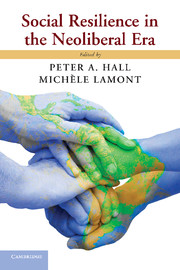Book contents
- Frontmatter
- Contents
- Contributors
- Foreword
- Prologue
- Acknowledgments
- Introduction
- Part I Neoliberalism
- Part II The Social Sources of Individual Resilience
- Part III Social Resilience on a Macro Scale
- 7 Neoliberalism and Social Resilience in the Developed Democracies
- 8 National Differences in Population Health and Development
- PART IV Communities and Organizations as Sites for Social Resilience
- Index
- References
8 - National Differences in Population Health and Development
Published online by Cambridge University Press: 05 May 2013
- Frontmatter
- Contents
- Contributors
- Foreword
- Prologue
- Acknowledgments
- Introduction
- Part I Neoliberalism
- Part II The Social Sources of Individual Resilience
- Part III Social Resilience on a Macro Scale
- 7 Neoliberalism and Social Resilience in the Developed Democracies
- 8 National Differences in Population Health and Development
- PART IV Communities and Organizations as Sites for Social Resilience
- Index
- References
Summary
Evaluating Social Resilience: Population Health and Development Outcomes
As Evans and Sewell argued in Chapter 1, the period from around 1980 forward can be described as a “neoliberal era” during which a set of economic and political forces, underpinned by a relatively clear ideological perspective, revamped the post–World War II consensus that had coalesced around modest levels of state intervention. Although there are other aspects of a more general trend toward globalization before and during this neoliberal turn, it is fair to note that the impact on social organization and action of neoliberalism was profound. Evans and Sewell identify central features linked to this shift, including a turn toward economic and social policies that focused more on private and market-driven rather than collective or state-driven solutions to social challenges, on deregulation of market forces, and on individual responsibility rather than shared risk and public protection against negative economic events. In some countries, these policies were aligned with an explicit ideological movement that strongly affected the social imaginary – Margaret Thatcher's claim that “there is no such thing as society” comes immediately to mind – but in others the shifts were a pragmatic response to real or perceived mandates from external powerful actors, often characterized as global market forces.
A key question animating this volume is how effectively different societies responded to this set of challenges. The core construct is the notion of resilience, which draws attention to differences across societies in the quality and effectiveness of how they dealt with the neoliberal challenge. This chapter looks at important outcomes in population health and development and then examines whether such differences in population outcomes can be systematically linked to identifiable aspects of different societal responses.
- Type
- Chapter
- Information
- Social Resilience in the Neoliberal Era , pp. 239 - 264Publisher: Cambridge University PressPrint publication year: 2013
References
- 2
- Cited by

